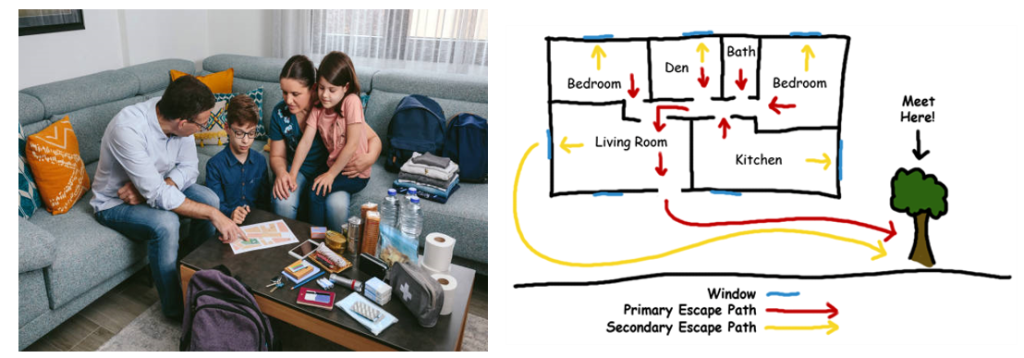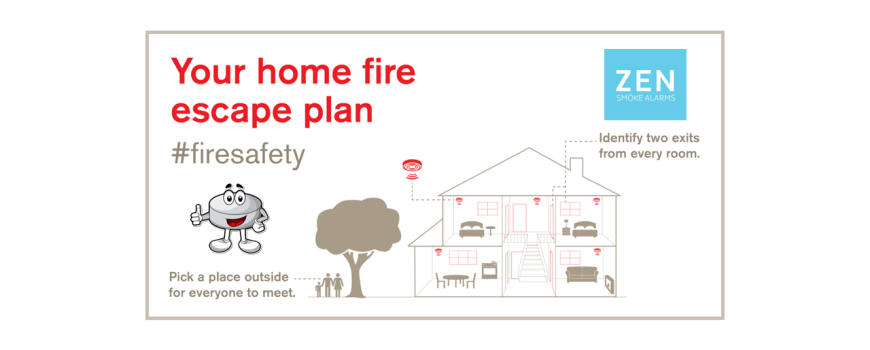There is no point waiting until a fire occurs before figuring out what to do and where to go—especially when the safety of your family is at stake. In an emergency, every second counts, and hesitation can be deadly. Having interconnected smoke detectors ensures that when one alarm detects smoke, all alarms in the home will sound, providing an early warning.
Coupled with a well-developed and regularly rehearsed home fire escape plan, this can give your loved ones the crucial time needed to escape safely. This practical blog post walks you through the benefits of interconnected smoke detectors and also the key steps of creating an effective fire escape plan, demonstrating that it’s a simple yet life-saving task that every household should prioritize.

Interconnected smoke detectors – do you have a home fire escape plan?
Develop A Floor Plan And Identify The Emergency Exit Paths
The main purpose of a home fire escape plan is to provide the occupants of a dwelling sufficient knowledge and skill to escape a burning building. This is achieved by a) documenting the required information b) communicating the information and then c) practicing the home fire escape plan.
The first step in developing a home fire escape plan is to draw a basic floor plan or map of your house, including key locations such as bedrooms, living areas, hallways, and all possible exits. Clearly mark doors, windows, and any alternative escape routes. This visual guide helps everyone understand the layout and potential escape paths.
Once the floor plan is drawn, gather all household members and review it together. Identify both a primary and secondary exit for each person, ensuring there are always two escape routes in case one is blocked by fire or smoke. Some things to consider—are there obstacles like large furniture, staircases, or security screens that could slow down an escape? If so, plan how to navigate them quickly and safely.
Think about ‘landmarks’ along the way that could assist in low-visibility conditions, such as walls, handrails, or textured flooring, to help guide movement in thick smoke. Consider any family members who may require extra assistance, such as young children, elderly residents, or individuals with limited mobility. If needed, assign a ‘buddy’ to assist them during an evacuation.
Finally, choose and agree on a safe muster point outside the home, such as a letterbox, a large tree, or a neighbour’s driveway. This ensures everyone gathers in a designated safe area after escaping, allowing for a quick headcount to confirm all occupants have evacuated successfully.

Interconnected smoke detectors – develop a home fire escape plan with all your family
Practice The Home Fire Escape Plan
It’s one thing to talk about it, but it’s another to actually do it. Rehearsing your home fire escape plan is critical to ensuring every household member knows exactly what to do in an emergency. Physically practice escaping twice a year with EVERY member of the household, including children and elderly residents. Consider running drills at different times of the day, including nighttime, to simulate real-life conditions.
During the rehearsal, a mobile phone timer can create a sense of urgency, helping family members understand how quickly they need to react. To simulate the reduced visibility caused by thick smoke, place a blindfold on the occupant and have them attempt to navigate the exit path in a controlled manner. This builds familiarity with the layout of the home and ensures that everyone can exit safely, even under stressful conditions.
Once outside, all members should gather at the fire escape plan’s designated muster point, ensuring no one is left behind. Conduct an after-action review to identify any obstacles, confusion, or areas for improvement. Document the time taken to escape and use it as a benchmark for future rehearsals, aiming to improve reaction time and efficiency.
Interconnected Smoke Detectors
And The Home Fire Escape Plan
ZEN interconnected smoke detectors provide greater early warning and response time to a fire – they should be installed within your home and form part of the overall home fire escape plan. Ensure interconnected smoke detectors are installed in every bedroom, communal hallway outside the bedrooms and if in a multi-story dwelling then at least one on every floor.
During the rehearsal of the home fire escape plan, test the photoelectric interconnected smoke detectors so all actually activate, and everyone becomes acquainted with their sound and meaning. Doing so may help lessen the sense of surprise or shock in a real-life fire event, and it is especially important for children who may not associate the interconnected smoke detectors sound with danger.

Fire Safety Essentials
Rehearsing your home fire escape plan is a great opportunity to impart some basic fire safety essentials. You may wish to document the following information in your home fire escape plan and ensure it is understood by all;
- Immediately phone triple zero 000 for Australian emergency services, including the fire department.
- Stay low to the ground to minimize inhaling toxic smoke and fumes which generally rise.
- Prior to opening a door, test it using the back of the hand to ascertain if there is heat on the other side.
- Close doors (but don’t lock) as you pass through them to limit air supply and possible expansion of the fire.
- Once outside at the designated muster point perform a head count. Do not head back inside the burning building for any reason.

Interconnected Smoke Detectors
And The Home Fire Escape Plan – Summary
A home fire escape plan should be unique to each residence, and the occupants should be familiar with it. Review the home fire escape plan bi-annually and practice escaping from the building so that theoretical knowledge becomes reality. Ensure ZEN interconnected smoke detectors are installed and test the interconnected smoke detectors during the practice-run. Basic fire safety essentials should also be added to the home fire escape plan and practiced – doing so will increase the opportunity for your loved ones to escape a burning home in a real-life emergency situation.

Want to know more? Watch our ZEN Smoke Alarm YouTube channel or call us on 0478 596 402 today
We love talking smoke alarms!
ZEN Interconnected Smoke Alarms
New Farm, QLD, 4005

